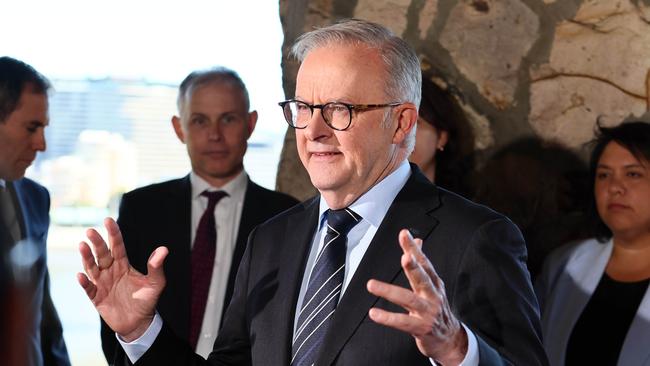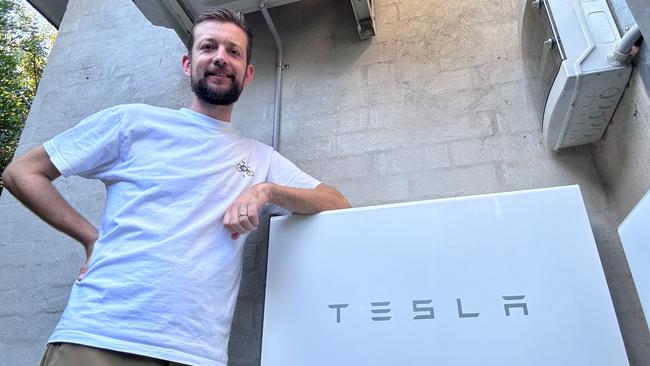Battery boom: Labor’s 30pc home battery subsidy threatens power struggle between households and retailers
Demand for batteries will soar from July 1 under a Labor scheme, boosting the nation’s energy transition. But it could also uproot the business model of traditional retailers.
Business
Don't miss out on the headlines from Business. Followed categories will be added to My News.
Australia’s rooftop solar revolution is heading for its next iteration: make way for the batteries.
From July 1, the federal government will subsidise household battery installations by up to 30 per cent, a move expected to stoke untapped consumer demand and inject a new dynamic into wholesale energy prices which are routinely trading below zero when renewables are plentiful.
Labor’s policy is designed to accelerate the transition toward its 2030 target of sourcing 82 per cent of electricity from renewable sources. During the day, solar exports push wholesale prices negative, straining coal-fired generators and accelerating their exit from the market.
But the transition has also introduced significant volatility into the grid — and batteries are seen as critical to smoothing out those extremes.
They may have another role to play: broadening battery schemes beyond the virtual power plants (VPPs) energy retailers have popularised.
Jon Briskin, head of retail at Origin Energy, says the looming incentive has seen an immediate uptick in interest.

“Origin and SolarQuotes saw a record-breaking month for battery inquiries, up a remarkable 400 per cent in May on the prior month,” Mr Briskin said.
While batteries may help stabilise the grid, they also pose a disruptive threat. For years, energy giants like AGL Energy and Origin have operated household batteries through VPPs, where thousands of devices are remotely controlled to either supply electricity to customers or profit from price spikes in the wholesale market.
However, the model delivers limited monetary value back to the household.
Critics, including the Australian Energy Market Commission, argue that VPP participants are undercompensated and have little clues how and when their battery is being used.
Retailers strongly reject this criticism, insisting they offer competitive rewards. A financially stable energy sector is essential to keeping bills low and reliability high, they argue.
Amber Electric is an example of the new breed of competitor enabled by affordable batteries. The Melbourne-based start-up has carved out a niche by putting control back in the hands of consumers, rather than managing batteries for their customers.
Alternatively, customers can opt to let Amber’s artificial intelligence run their batteries.

Dan Adams, co-founder of Amber, says the model offers substantial savings compared to the incumbent system.
“Under the VPP model, the utility pays you $200 or $300 a year for access and to control your battery. And then the utility goes and makes money out of your asset. Our model is, we help you make money out of your own asset, and you get the full financial value out of your asset. The only money that we make is we charge a fixed $22 a month subscription,” Mr Adams told The Australian.
Amber customers are also exposed to downside risk. If a household has drained its battery, weather conditions are unfavourable and wholesale prices have spiked, the customer would be exposed to market rates for power.
Traditional VPP customers would be on a standard tariff scheme, drawing from the grid and this would incur them some protection.

With just 40,000 customer accounts, Amber is a minnow. Some industry executives see it as a potential disrupter in a sector long dominated by vertically integrated players.
The July 1 subsidy, by dramatically reducing battery costs and expanding the market of potential customers, could bolster its fortunes, or inspire copycats.
It also coincides with the rise of electric vehicles, further increasing the pool of mobile energy storage assets in Australian homes.
EVs, supported by separate federal tax incentives, are expected to double as energy storage units thanks to emerging bidirectional charging technology. Regulators are gradually approving the use of two-way chargers, which allow EVs to not only draw power from the grid but also export it back — potentially transforming cars into a new class of household battery.
Until now, households have used rooftop solar or cheap grid prices to charge their EVs. But with vehicle-to-grid known as V2G charging on the horizon, the family car could soon play a more active — and lucrative — role in the energy market.
AGL and Origin are expanding their battery and solar offerings and bundling them with retail plans, finance packages and installation services aiming to lock in customers.
Whether the future belongs to the traditional players or the new wave of consumer-focused disrupters will depend on how quickly households adopt batteries — and how much control they want over them.
From July 1, the battery boom is no longer a fringe story. It’s central to the future of Australia’s energy system and the battle for who gets paid is only beginning.
More Coverage
Originally published as Battery boom: Labor’s 30pc home battery subsidy threatens power struggle between households and retailers





